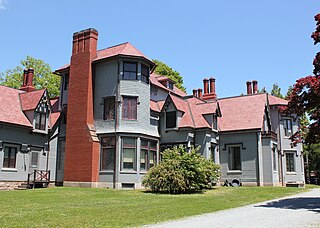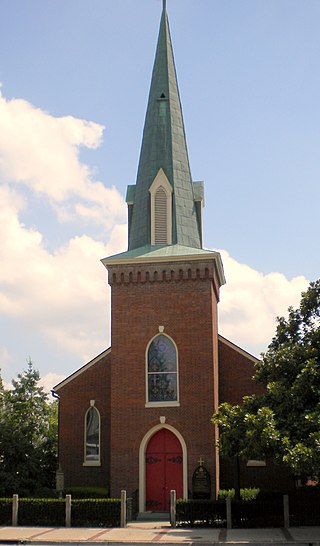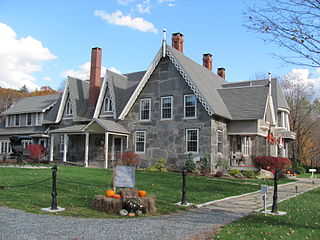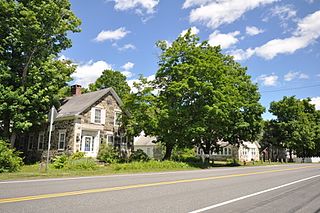
Kingscote is a Gothic Revival mansion and house museum at Bowery Street and Bellevue Avenue in Newport, Rhode Island, designed by Richard Upjohn and built in 1839. As one of the first summer "cottages" constructed in Newport, it is now a National Historic Landmark. It was remodeled and extended by George Champlin Mason and later by Stanford White. It was owned by the King family from 1864 until 1972, when it was given to the Preservation Society of Newport County.

The William Trent House is a historic building located at 15 Market Street in Trenton, Mercer County, New Jersey. It was built in 1719 for William Trent and is the oldest building in Trenton. He founded the eponymous town, which became the capital of New Jersey. It has served as the residence for three Governors. The house was added to the National Register of Historic Places and listed as a National Historic Landmark on April 15, 1970, for its significance as an example of Early Georgian Colonial architecture.

Wendover, also known as Frontier Nursing Service or Big House, is a historic house and former medical care facility near Hyden, Kentucky. Built in 1925, it is notable for its association with the American effort to professionalize midwifery, led by Mary Breckinridge (1881-1965). It was headquarters of the Frontier Nursing Service, an organization which continues today. Wendover was named a U.S. National Historic Landmark in 1991 for this role. It now serves as a bed and breakfast inn and retreat operated by the Service's successor, Frontier Nursing University.

The Wynkoop House is located on New York Route 32 just north of an offramp from the New York State Thruway and its junction with NY 212 in the town of Saugerties, New York, United States. It is a linear stone house built in two sections by the descendants of Dutch settlers around 1740, and renovated in later years.
Big Bottom Farm is a farm in Allegany County, Maryland, USA on the National Register of Historic Places. The Greek Revival house was built circa 1845, possibly by John Jacob Smouse, and exhibits a level of historically accurate detailing unusual for the area. The property includes a late 19th-century barn and several frame outbuildings.

Trinity Episcopal Church in Danville, Kentucky was one of the first churches organized in the Episcopal Diocese of Kentucky. Trinity Church is the oldest in-use church structure in Danville and the oldest continuously used Episcopal church building in the Episcopal Diocese of Lexington as well as the second oldest in Kentucky. It is listed in the National Register of Historic Places.

The Jefferson–Chalmers Historic Business District is a neighborhood located on East Jefferson Avenue between Eastlawn Street and Alter Road in Detroit, Michigan. The district is the only continuously intact commercial district remaining along East Jefferson Avenue, and was listed on the National Register of Historic Places in 2004.

The Lower Shell School House is located in an isolated portion of Big Horn County, Wyoming on a bluff near Shell Creek. The one-room schoolhouse was built in 1903, and was one of the first buildings in the area that did not use log construction. The school functioned as a church and Sunday school, and as a community meeting place. It was used as a school until the 1950s, and as a community meeting house until the 1970s.

Grace United Methodist Church is a historic Methodist Church building at 34 Court Street in Keene, New Hampshire. Built in 1869, it was designed by architect Shepard S. Woodcock, and is one of the largest churches in southwestern New Hampshire. It was added to the National Register of Historic Places in 1985. Its congregation moved in 2009 and was disbanded in 2016, and the building is undergoing renovation for use as professional offices.
The Union Church of Vinalhaven is a historic church on East Main Street in the center of Vinalhaven, Maine. Built in 1899, it is a high quality example of Shingle style architecture, designed by one of its major promoters, John Calvin Stevens. It was listed on the National Register of Historic Places in 1984.

St. Paul's Episcopal Church is a historic church building at Bridge Street and Vermont Route 14 in Royalton, Vermont. Built in 1836, it is a prominent early example of Gothic Revival architecture in the state, and is one of the oldest surviving public buildings in Royalton's historic village center. Now deconsecrated and maintained by the Royalton Historical Society, it was listed on the National Register of Historic Places in 2001.
Oil Springs Methodist Church is a historic church at the junction of KY 580 and KY 40 in Oil Springs, Kentucky. It was built in 1893 and added to the National Register in 1989.

St. Lawrence Catholic Church is a parish of the Archdiocese of Dubuque. It is located in rural Jackson County, Iowa, United States, in Otter Creek Township. It was listed on the National Register of Historic Places in 1992.
Moran House may refer to:

The John Littig House is a historic building located on the northwest side of Davenport, Iowa, United States. The Gothic Revival style residence was built in 1867 and has been listed on the National Register of Historic Places since 1984 and on the Davenport Register of Historic Properties since 1993.

First Presbyterian Church is a Presbyterian Church (USA) church located in Muscatine, Iowa, United States. It, along with the attached Sunday School building, were listed on the National Register of Historic Places in 1977.

Glimmerstone is a historic mansion house on Vermont Route 131, west of the village center of Cavendish, Vermont. Built 1844–47, it is a distinctive example of Gothic Revival architecture, built using a regional construction style called "snecked ashlar" out of locally quarried stone flecked with mica. The house was listed on the National Register of Historic Places in 1978.

The Frog Hollow Stone Mill, or as it is now referred to, TheStone Mill, is a historic industrial building at 3 Mill Street in Middlebury, Vermont. Built in 1840, it is an important local reminder of the town's industrial past, and was listed on the National Register of Historic Places in 1973. It presently houses a restaurant, a public market, event space and four hotel rooms as part of an extensive renovation conducted in 2019.

The Stone Village Historic District encompasses a distinctive collection of stone buildings on Vermont Route 103 in Chester, Vermont, United States. Dating to the first half of the 19th century are a remarkable concentration of buildings constructed in a regionally distinctive snecked ashlar technique brought to the area by Scottish masons. The district was listed on the National Register of Historic Places in 1974.

The Whittier House is a historic house on Greenbanks Hollow Road in Danville, Vermont. Built in 1785, it is significant as one of the town's oldest surviving buildings, and as an example of a gambrel-roofed Cape, a style rare in northern Vermont but common to Essex County, Massachusetts, where its builder was from. The house was listed on the National Register of Historic Places in 1984.


















